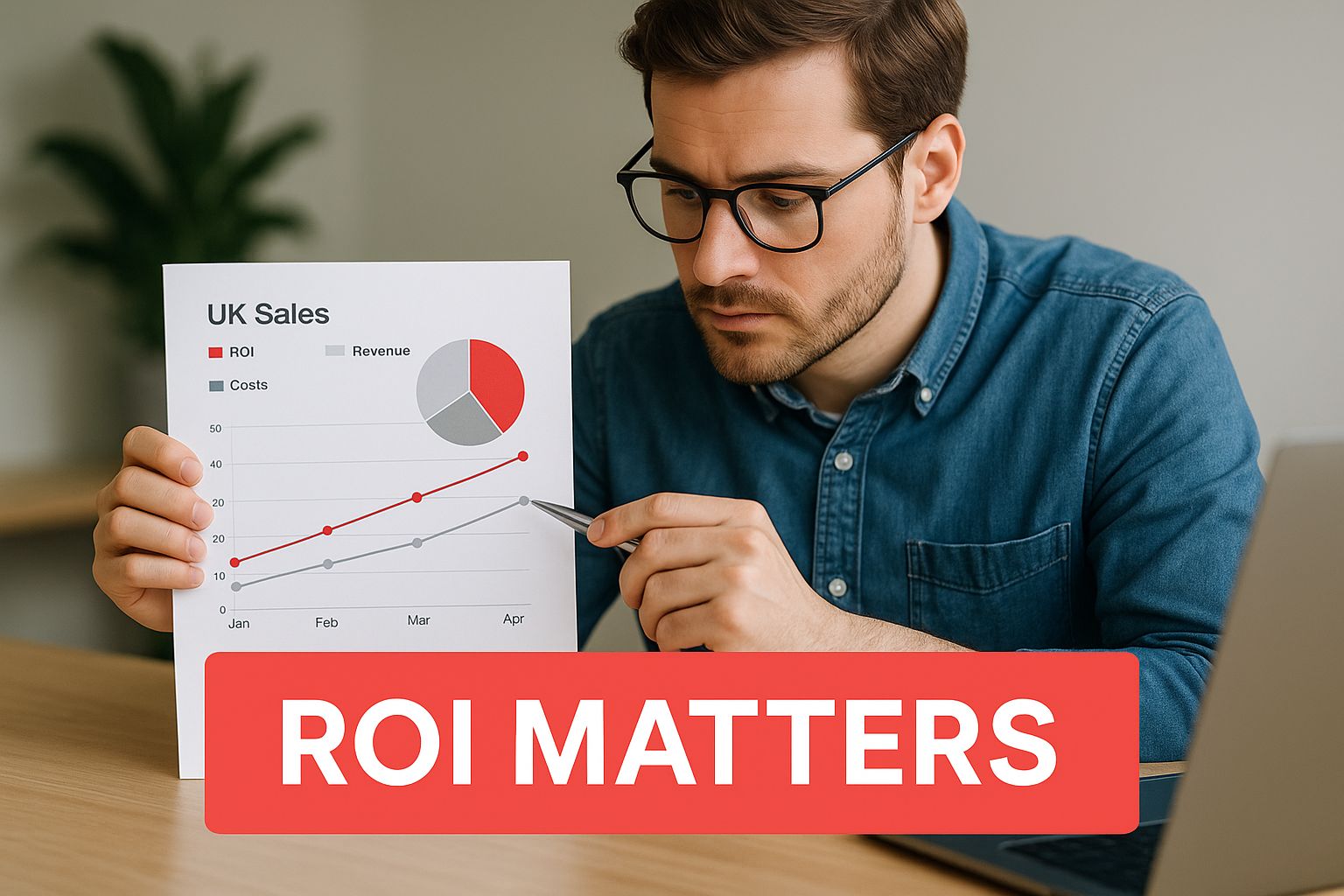How to Measure ROI: A UK Marketer's Guide
To get your ROI, you take the final profit, subtract what you initially spent, and then divide that number by the original cost. The classic formula, ROI = (Net Profit / Cost of Investment) x 100 , spits out a simple percentage. It tells you exactly how much bang you got for your buck.
Why Measuring Marketing ROI Is Non-Negotiable
Let's be realistic. Proving the value of marketing can sometimes feel like you’re shouting into the wind. You launch campaigns, you get likes, you drive traffic, but when the board asks, "What did we actually get for our money?", you need a solid answer.
This is where knowing how to measure Return on Investment becomes your superpower.
It shifts the conversation from vague feelings about a campaign’s success to cold, hard data proving its financial worth. A firm grip on ROI lets you:
- Justify Your Budget: Show the decision-makers exactly what their investment achieved in pounds and pence.
- Make Smarter Decisions: Pinpoint which campaigns are hitting it out of the park and which ones are just draining cash.
- Champion Your Success: Clearly demonstrate how marketing directly fuels the company's bottom line.
A Practical Example of ROI in Action
Picture a small UK-based online shop that sells handmade leather goods. They decide to put £2,000 into a highly targeted social media ad campaign to launch a new line of wallets.
Over the next month, that campaign directly brings in £7,000 in sales.
So, how did they do? Using the basic ROI formula, the maths looks like this:
ROI = (£7,000 Revenue - £2,000 Cost) / £2,000 Cost x 100
This simple sum shows a net profit of £5,000 and an incredible 250% ROI . For every £1 they spent, they made £2.50 back in profit. That single number provides instant clarity.

The retailer now has concrete proof that their strategy is a winner. This gives them the confidence to reinvest in what works and plan future marketing spend without guessing. It's this fundamental understanding that paves the way for much deeper analysis down the line.
The Core ROI Formula and Essential Metrics

Before you can truly get a handle on your marketing ROI, you need to get comfortable with the fundamental formula. At its core, the calculation is refreshingly simple, giving you a clear percentage that shows you exactly what you got back.
The formula is: (Net Profit / Total Investment) x 100 = ROI %
This calculation gives you a straight answer on what you spent versus what you earned. A positive percentage means you’re in the black, while a negative one shows a loss. Simple.
What Is Your Total Investment, Really?
One of the biggest mistakes I see people make is undercooking the ‘Total Investment’ figure. It’s so much more than just what you paid for ads. To get a true picture, you have to be honest and track every single cost tied to that campaign.
Think beyond the obvious. Your investment includes:
- Ad Spend: The direct cost for your ads on Google, Meta, or any other platform.
- Software Subscriptions: Fees for your analytics platforms, email marketing services, CRM, and scheduling tools.
- Creative Costs: The money spent on design work, video production, or hiring that freelance copywriter.
- Staff Time: A portion of the salaries for the team members who managed and ran the campaign.
If you forget these costs, your ROI will look artificially high, and you'll be making decisions based on bad data. A full, honest view of your investment is non-negotiable.
Nailing Down Your Net Profit
In the same way, figuring out your ‘Net Profit’ isn’t just about looking at total revenue. You absolutely have to subtract the cost of delivering the product or service, often called the Cost of Goods Sold (COGS) .
Let's say a campaign brought in £10,000 in revenue . If the products themselves cost £3,000 to produce and deliver, your gross profit is actually £7,000 . It is this number—not the headline revenue—that feeds into your ROI calculation.
Getting ROI right means being brutally honest about both your total investment and your true profit. Glossing over hidden costs or ignoring COGS will only lead to flawed data and, ultimately, poor strategic decisions.
Measuring digital ROI in the UK has become more sophisticated, as businesses now track both direct and indirect revenue streams. While the basic formula is the same, UK companies are getting smarter at combining direct attribution with methods that capture offline conversions. It is no surprise that by 2025, 66% of UK firms reported better customer retention after making these kinds of tracking improvements, proving the value of seeing the long-term picture.
Crucial Metrics That Give Your ROI Context
While the main formula gives you the headline number, diving into other essential digital marketing performance metrics provides the nuance you need to truly understand campaign performance. Two of the most important supporting acts are Customer Acquisition Cost (CAC) and Customer Lifetime Value (LTV).
Before we dig into those, it's helpful to see all the key players in one place. Here’s a quick rundown of the metrics that form the backbone of any solid ROI analysis.
Key Metrics for Calculating Marketing ROI
| Metric | Formula | What It Measures |
|---|---|---|
| Return on Investment (ROI) | (Net Profit / Total Investment) x 100 | The overall profitability of a marketing campaign. |
| Net Profit | Revenue - Cost of Goods Sold (COGS) | The actual profit generated before deducting marketing investment. |
| Total Investment | Ad Spend + Tools + Creative + Staff Costs | The complete cost associated with running a campaign. |
| Customer Acquisition Cost (CAC) | Total Marketing Spend / New Customers Acquired | How much it costs, on average, to gain one new customer. |
| Customer Lifetime Value (LTV) | (Avg. Purchase Value x Avg. Purchase Frequency) x Avg. Customer Lifespan | The total predicted profit from a single customer over their entire relationship with your business. |
This table lays out the core components, but the real magic happens when you understand how they influence each other, especially LTV and CAC.
- Customer Acquisition Cost (CAC): This tells you exactly what it costs to win a new customer. You calculate it by dividing your total marketing and sales spend by the number of new customers you brought in over a set period.
- Customer Lifetime Value (LTV): This metric forecasts the total profit your business can expect from a single customer. A high LTV is a sign of great customer loyalty and healthy, recurring revenue.
The relationship between LTV and CAC is everything. A healthy, scalable business model typically has an LTV that is at least three times its CAC. If you want to go deeper on these and other critical numbers, check out our complete guide on https://www.superhub.biz/mastering-marketing-performance-metrics.
Calculating ROI Across Different Marketing Channels

Trying to measure your marketing ROI with a single, one-size-fits-all formula is a recipe for confusion. It just does not work.
The way you measure the impact of a fast-and-furious Google Ads campaign is completely different from how you would assess the slow-burn value of your blog. Every channel has its own quirks, its own costs, and its own timeline to deliver results.
Getting your head around these differences is the secret to figuring out what’s actually moving the needle. So, let’s get practical and break down how you can measure ROI for the most common marketing channels, applying the right lens to each.
Measuring Pay Per Click ROI
At first glance, Pay Per Click (PPC) advertising seems like the easiest channel to measure. Platforms like Google Ads and Meta give you a shiny metric called Return on Ad Spend (ROAS) , which looks great on a report.
But here’s the catch: ROAS is not the same as ROI. Not even close. ROAS only compares the revenue against what you spent on the ads themselves. To get the real ROI, you have to factor in everything else – the agency fees, the cost of creating the ad visuals, and even the portion of your team’s salary that goes into managing it all.
Let’s run through a quick example. Imagine a UK-based clothing brand spends £5,000 on Google Ads and pays an agency another £1,000 in management fees . The campaign brings in £20,000 in revenue , but the clothes themselves cost £8,000 to produce (cost of goods sold, or COGS).
- Total Investment: £5,000 (Ad Spend) + £1,000 (Fees) = £6,000
- Net Profit: £20,000 (Revenue) - £8,000 (COGS) - £6,000 (Total Investment) = £6,000
- PPC ROI: (£6,000 Net Profit / £6,000 Total Investment) x 100 = 100%
That 100% ROI gives you a much clearer picture. It tells you that for every £1 you put in, you got £1 back in pure profit. That’s a far more useful metric for making business decisions than a simple ROAS figure.
Attributing ROI to Content Marketing
Content marketing is the long game. This makes its ROI notoriously difficult to nail down. A blog post you publish today might not bring in a qualified lead for six months, but its value quietly compounds over time as it climbs the search rankings and builds your authority.
This is why you have to track both direct and indirect conversions. A direct conversion is easy—someone reads a blog, clicks the "book a call" button, and becomes a lead. Simple. An indirect or "assisted" conversion is more common: a user reads that same blog post, leaves, and then comes back a few weeks later via a different channel to finally convert.
Do not underestimate the power of content. In the UK, it’s one of the most efficient channels out there. For 2025, the average ROI for content marketing is a staggering £7.65 for every £1 spent. We also know that businesses that maintain a blog generate 55% more website traffic and a whopping 67% more leads than those that do not. You can find more stats on how UK businesses are winning with content over on SQ Magazine.
The real value of content often lies in its long-term impact on brand trust and organic visibility. Do not just measure immediate leads; track metrics like growth in branded search queries and direct website traffic to see its full influence.
Figuring Out Social Media ROI
With social media, your ROI calculation comes down to one simple question: what are you trying to achieve? Your goals dictate everything. Are you running ads to drive immediate sales, or are you focused on building a community and getting your brand name out there? These are two very different objectives that need two very different ways of measuring success.
If you’re running direct-response ads, the maths is a lot like PPC. You track your ad spend, creative costs, and management time against the revenue that comes in directly from those campaigns.
But for brand-building, the link to revenue is much softer. Here, you need to look at leading indicators—the metrics that suggest future success is on the horizon. Keep a close eye on:
- Engagement Rate: Are people liking, sharing, commenting, and saving your posts? It shows your message is hitting the mark.
- Follower Growth: A growing audience means your brand’s reach is expanding.
- Website Clicks: How many people are curious enough to click the link in your bio or in a post to check out your website?
By blending the hard numbers from paid social with the softer metrics from your organic efforts, you can build a complete picture of your performance. For businesses looking to tie these different threads together, our guide on maximising ROI with a multi-channel marketing approach provides a solid strategic framework.
The Right Tools for Tracking and Analysing ROI
Trying to measure your marketing ROI with spreadsheets and guesswork is a recipe for frustration. To get accurate, actionable data, you need the right tools in your arsenal. These platforms do the heavy lifting, connecting your spending to actual results and giving you a clear view of what’s really working.
The right tech stack gets rid of the manual slog and the risk of human error, making sure your decisions are built on solid ground. Without it, you’re basically flying blind, unable to prove the value of your marketing efforts when it matters most.
Web Analytics Platforms
For most UK businesses, the journey begins with a solid web analytics platform. Google Analytics 4 (GA4) is the industry standard for a reason, and it’s the essential first step to understanding how people actually interact with your website.
Its real power in measuring ROI comes from setting up specific conversion goals. These are not just about sales; a goal could be anything from a form submission or a whitepaper download to someone viewing a key page. By tracking these actions, GA4 helps you attribute value to different traffic sources, showing you which channels are bringing in the most valuable visitors. This data is the foundation for any serious ROI analysis.
Customer Relationship Management Systems
While analytics shows you what happens on your site, a Customer Relationship Management (CRM) system tells you the story of your leads and customers. Platforms like HubSpot or Salesforce are built to track the entire customer journey, from their very first interaction with your brand to the final sale and beyond.
A CRM connects your marketing efforts directly to sales revenue. For instance, you can see if a lead that came from a specific blog post eventually turned into a high-value client. This kind of closed-loop reporting is the gold standard for accurately calculating your marketing ROI, especially for businesses with longer sales cycles.
By integrating your marketing platforms with a CRM, you create a single source of truth for all your data. This allows you to track how marketing-sourced leads progress through the sales pipeline and accurately attribute revenue back to specific campaigns.
Specialised Reporting Dashboards
As your marketing grows, so does your data. It gets scattered across social media, email marketing tools, ad networks, and your CRM. Trying to pull all this information together by hand is not just a headache; it’s a minefield of potential mistakes.
This is where specialised reporting dashboards come in. Tools like Looker Studio (formerly Google Data Studio) or other paid alternatives can pull data from all your different sources into one unified, easy-to-read dashboard. They visualise your performance, making it simple to spot trends and compare how different channels are performing side-by-side.
For any business serious about harnessing the power of data-driven marketing strategies for success , a centralised dashboard is non-negotiable. It turns raw numbers into clear insights, helping you make smarter, faster decisions to boost your overall ROI.
Beyond the Basics: Attribution and Lifetime Value
A simple ROI calculation gives you a good starting point, but if you want to really understand what moves the needle for your business, you have to dig deeper. The real gold is found when you move past the basic formulas and start getting to grips with attribution and customer lifetime value.
These are the concepts that tell the whole story behind a sale. They show you how different marketing channels work together and reveal what a loyal customer is really worth to you over the years.
Demystifying Marketing Attribution
Think about a typical customer journey. A potential buyer might first see your brand in a paid social media ad. A week later, they click through to read one of your blog posts. Finally, they make a purchase after finding you through a Google search.
So, which of those touchpoints gets the credit? That’s the core question marketing attribution sets out to answer.
Most standard models give you a skewed picture:
- First-Touch Attribution: This gives 100% of the credit to that first social media ad. It’s great for seeing what initially catches someone's eye, but it completely ignores everything that happens afterwards.
- Last-Touch Attribution: This gives 100% of the credit to the final Google search. It tells you what sealed the deal, but overlooks all the crucial groundwork that built awareness and trust.
Honestly, these single-touch models are just too basic for most businesses today. A much more honest approach is multi-touch attribution . This method splits the credit across multiple touchpoints, acknowledging that each interaction played its part in getting that final conversion. If you want to dive deeper into how different touchpoints contribute, it is worth exploring What is Attribution Modeling.
The Power of Customer Lifetime Value
While attribution clarifies how a conversion happened, Customer Lifetime Value (LTV) puts the focus on the long-term worth of that customer. It’s a shift in mindset from chasing short-term campaign wins to building sustainable, profitable growth.
LTV is all about predicting the total net profit you’ll make from a customer over the entire time they do business with you. A high LTV is a sign of a healthy business with loyal customers who keep coming back—which is always far cheaper than constantly having to find new ones.
Knowing your LTV is a genuine game-changer. It gives you the confidence to justify spending a bit more to acquire a new customer (your Customer Acquisition Cost, or CAC) because you know what they’re likely to be worth in the long run. As a rule of thumb, a healthy business aims for an LTV that is at least three times its CAC.
In the UK, email marketing is still an absolute titan when it comes to driving LTV. Projections for 2025 put its average ROI somewhere between a staggering 3,600% and 3,800% . That’s £36 to £38 back for every £1 you put in. This incredible return is not just about the first sale; it is about email's power to nurture relationships for the long haul, which is the very essence of a high lifetime value. You can find more stats on this over at emailmonday.com.
Burning Questions on Measuring ROI
Even with the formulas down, real-world questions always crop up when it is time to put theory into practice. Let's tackle some of the most common queries we hear from UK marketers trying to get a real handle on their numbers.
Getting these answers right is what bridges the gap between knowing what ROI is and confidently using it to make smart decisions.
How Often Should I Be Measuring My Marketing ROI?
There is no magic number here. The right frequency comes down to your sales cycle.
An e-commerce brand pushing weekly promos needs to be agile. A monthly ROI review makes sense, letting them quickly pivot away from campaigns that are not hitting the mark.
On the flip side, a B2B company with a six-month sales cycle will not get much from weekly check-ins. A quarterly review is far more practical, giving their strategies the time they need to actually deliver results. The trick is to measure often enough to adapt, but not so often you’re just reacting to noise.
What’s a Good Marketing ROI in the UK Anyway?
Everyone wants a target to aim for, but a "good" ROI really depends on your industry, profit margins, and even the marketing channel you are using.
That said, a generally accepted benchmark to feel good about is a 5:1 ratio .
That means for every £1 you spend, you are generating £5 in revenue. Some channels, like a well-oiled email marketing machine, can blow this out of the water, sometimes hitting returns of over 30:1 .
But here’s the real secret: the most important benchmark is your own. Focus on improving your ROI quarter-on-quarter instead of chasing a generic number that might have nothing to do with your business.
How on Earth Do I Measure ROI for Brand Awareness?
Ah, the classic question. How do you measure something as fuzzy as brand awareness?
Activities like organic social media or PR do not have a clean line to a sale, so a simple profit calculation is off the table. The solution is to track proxy metrics – these are the leading indicators that tell you revenue is likely to follow.
Instead of profit, you focus on tracking real shifts in how people behave. Look for things like:
- A jump in branded search volume (are more people Googling your company name?).
- A rise in direct website traffic (are more people typing your URL straight into their browser?).
- Better engagement rates on your social media posts.
These metrics are solid proof that your brand-building is working. While you will not get a perfect ROI percentage, you can clearly show the value these activities are adding at the top of your funnel, warming up future customers.
Ready to stop guessing and start getting clear, data-driven answers about your marketing performance? The expert team at Superhub can help you implement the strategies and tools needed to accurately measure and maximise your return on investment. Visit us at https://www.superhub.biz to learn how we can help your business grow.





